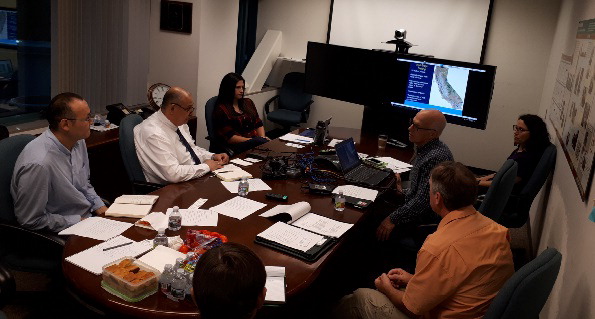|
Cycle 5 (2015 Deadline)
Provision of science based evidence on climate induced water quality challenges in Amu Darya basin
PI: Iskandar Abdullaev (iabdullaev@carececo.org), Regional Environmental Center for Central Asia (CAREC)
U.S. Partner: Antarpreet Jutla, West Virginia University
Project dates: December 2016 - May 2019
Project Overview
Most climate-related studies in Central Asia are focused on water quantity impacts and their implications for transboundary water allocation in the region. However, these studies have neither investigated nor documented the water quality aspects of climate change impacts, especially for Central Asia's two biggest river systems (Amu Darya and Syr Darya). This PEER project aimed to assess the impacts of climate change on surface water quality of the Amu Darya River and develop a climate change water quality model that will provide much needed information to decision makers for elaboration of possible adaptation actions. The project also transferred knowledge and data to the region and enhanced research capacities in Central Asia based on the tools, approaches, and methods applied.
The project was carried out by scientists from CAREC and counterparts from Afghanistan, Tajikistan, and Turkmenistan, including the basin organization BVO Amudarya, with special focus on building capacity in water quality maintenance at BVO Amudarya. In addition to helping with the calibration, validation, and simulation stages and analysis of results, the U.S. partner organized training workshops for CAREC researchers on methodological aspects and relevant numerical and analytical tools for water quality predictions.
Final Summary of Project Activities
 | | The project team discussed the project with U.S. partners during their trip to the United States (photo courtesy of Dr. Abdullaev). |
The PEER researchers began by analyzing the current literature on water quality issues in the Amu Darya River and similar hydrologic systems, building a research team and network of experts on the subject. The team members collected and systematized data on hydrology, water quality, and agriculture for the basin and in October 2017 they visited the U.S. Geological Service, California Water Science Center for a workshop on research methodology.
The project team members began their statistical analysis of hydrological, climate, and water quality data to establish a relationship between water quality and climate indicators. During the process, the team realized there were gaps in data from other countries such as Tajikistan and Turkmenistan. Therefore, two specialists were recruited to collect the missing data. A modeling exercise also revealed a need for additional data on agricultural water intake and discharge to the Amu Darya River basin. Therefore, the team requested additional data on monthly water quality parameters from the State Hydrometeorological Agency of Uzbekistan.
The researchers found that data availability and quality were relatively low and further endeavors in the region should be aimed at increasing the number of sampling stations, regularity of the observations, and recording of dates when the samples were made. They did observe relatively high phosphorus levels at all sampling stations, with high values at the upstream gauges, indicating possible point-source pollution. There was also a strong correlation between the mineralization and the discharge: the maximum levels of mineralization are occurring during the spring months during the low flow period and when the leaching of the drainage water is slightly higher. The relationship between the mineralization and discharge shows stronger correlation for the downstream gauges, allowing the suggestion that the dilution processes have stronger influence on the downstream water quality than the upstream. The team also found an inverse relationship between the phosphorus levels and discharge and direct relationship between the nitrogen and discharge, especially for the upstream stations.
The team hired experts from the Potsdam Climate Institute (PKI) to apply their model for analysis of the climate change and water quality linkages. Their results are in line with results of the PEER research team. During the project period researchers presented results at the Central Asian Environmental Forum and the Central Asian Climate conference. Although no published papers had appeared by the end of the project, the PEER team’s findings supported one graduate thesis. The researchers also shared their results with the regional working group on water quality and met with representatives of various basin organizations and nature protection agencies.
Back to PEER Cycle 5 Grant Recipients
|
|
|
|




